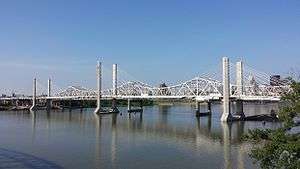Abraham Lincoln Bridge
| Abraham Lincoln Bridge | |
|---|---|
|
The Abraham Lincoln Bridge viewed from the Big Four Bridge | |
| Coordinates | 38°15′52″N 85°44′37″W / 38.26444°N 85.74361°WCoordinates: 38°15′52″N 85°44′37″W / 38.26444°N 85.74361°W |
| Carries |
6 lanes of northbound |
| Crosses | Ohio River |
| Locale | Louisville, Kentucky and Jeffersonville, Indiana |
| Characteristics | |
| Design | Cable-stayed bridge |
| Total length | 2,100 ft (640 m) |
| Longest span | 700 ft (213 m) × 2 spans |
| History | |
| Opened | December 6, 2015 |
 | |
The Abraham Lincoln Bridge is a six-lane, single-deck cable-stayed bridge carrying northbound Interstate 65 across the Ohio River, connecting Louisville, Kentucky and Jeffersonville, Indiana.[1] The main span is 700 feet (213 m) (two spans) and the bridge has a total length of 2,100 feet (640 m). It is named after U.S. President Abraham Lincoln, who was born in Kentucky and grew up in Southern Indiana.
History
The Abraham Lincoln Bridge opened on December 6, 2015, and is parallel to the John F. Kennedy Memorial Bridge upstream and now carries five lanes of northbound I-65 traffic, eventually carrying six lanes of northbound I-65 traffic.[2] Pedestrian and bicycle lanes were in the original plans, but have since been removed. The existing I-65 John F. Kennedy Memorial Bridge, completed in 1963, is being renovated for six lanes of southbound traffic. On October 10, 2016, five lanes of the Kennedy Bridge reopened, at which time the Lincoln Bridge began carrying only northbound traffic after several months of carrying three lanes of traffic in both directions. Both spans are expected to fully open, with six lanes of traffic in each direction, in December 2016.[3]
A Structured Public Involvement protocol developed by Drs. K. Bailey and T. Grossardt was used to elicit public preferences for the design of the structure. From spring 2005 to summer 2006 several hundred citizens attended a series of public meetings in Louisville, Kentucky and Jeffersonville, Indiana and evaluated a range of bridge design options using 3D visualizations. This public involvement process focused in on designs that the public felt were more suitable, as shown by their polling scores. The SPI public involvement process itself was evaluated by anonymous, real-time citizen polling at the open public meetings.
On July 19, 2006, the final design alternatives for the bridge were announced. The three designs included a three-span arch, a cable-stayed design with three towers, and a cable-stayed type with a single A-shaped support tower. It was also announced that the projected cost for the bridge would be $203 million.
The structure is an additional bridge in downtown Louisville joining the John F. Kennedy Memorial Bridge erected between spring 1961 and late 1963 at a cost of $10 million ($77.5 million in 2015 dollars); the four-lane George Rogers Clark Memorial Bridge, constructed from June 1928 and to October 31, 1929, and the Big Four Bridge, which operated as a railroad bridge from 1895 to 1969 and reopened as a pedestrian bridge in May 2014.
See also
- List of crossings of the Ohio River
- Butchertown, Louisville
- Kennedy Interchange ("Spaghetti Junction")
- Ohio River Bridges Project, the highway project of which this bridge is a part
References
- ↑ Shafer, Sheldon S. (November 30, 2015). "It's official! New bridge named for Lincoln". The Courier-Journal. Louisville. Retrieved 2015-11-30.
- ↑ Coghill, Erica (December 7, 2015). "Abraham Lincoln Bridge officially opens". WLKY. Louisville. Retrieved 2015-12-07.
- ↑ Helmer, Katrina (October 10, 2016). "Kennedy Bridge open 5 lanes of southbound traffic". Louisville: WDRB. Retrieved October 11, 2016.
